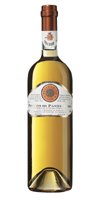On the sweet side of Languedoc-Roussillon value wines: Vin Doux Naturel and Domaine Cazes
Here's an interesting idea for WBW 33 -- a nectar-like wine that you can serve as an aperatif or as dessert! I'm talking about Vin Doux Naturel such as Banyuls or Rivesaltes, but if you've never heard of them, allow me to explain.
Vin doux naturel means "naturally sweet wine". That's in part becuase the grapes used to make it typically are high in natural sugar and therefore capable of reaching 15 percent alcohol during the vinification. To that, distilled spirits are added and essentially stop fermentation while further elevating the alcohol content. The resulting wines are usually 15 to 18 percent alcohol but can range as high as 21.5 percent. Generally white grape Vin Doux Naturel are sweeter and less alcoholic than reds.
I framed last week's posts on Vin de Pays as the legacy of Languedoc-Roussillon, but you could certainly revise that to say that Vin de Pays is the legacy of Languedoc while Vin Doux Naturel is the legacy of Roussillon. The larger western Languedoc does produce a little Vin Doux Naturel, but the smaller eastern Roussillon is the heavyweight producer, having nurtured, developed and actually invented this unique style of wine. (Other than a couple types of Vin Doux Naturel coming out of the Rhône Valley, this concoction is strictly a Languedoc-Roussillon regional wine.)
For the historical signifcance of vin doux naturel -- of which Port wine is sometimes considered part of its legacy -- I turned to The Oxford Companion to Wine. Its entry includes the following:
The Catalan alchemist Arnaldus de Villanova (Arnaud de Villeneuve) of Montpellier University's then-flourishing medical school perfected the [vin doux naturel vinification] process and in 1299 was granted a patent from the king of Majorca, then ruler of Roussillon, which was to become the world's centre of vin doux naturel production ...But for a more practical lesson, nothing beats a tasting of the stuff to understand what it is. Click on the thumbnails below to take a closer look at what my friends and I drank over the weekend.
This is essentially how port as we know it, created nearly 400 years later, is made strong and sweet, and the technique is also used in the production of madeira and málaga.



I chose to open a well-reviewed Muscat de Rivesaltes, which is just one official Vin Doux Naturel designation of many. As the name often implies with these sweet wines, the grape involved is obvious (sometimes tawnier versions of Vin Doux Naturel are made with Grenache grapes though that may not be apparent on the label).
Domaine Cazes Muscat de Rivesaltes 2003 reminded me a lot of my favourite Muscat treat called Passito-di-Pantelleria. Though I might still prefer the Sicilian in an after dinner situation for its intense fruit, slight hint of orange bitters and overall honeyed attack, this Riversaltes could slip in easily as an aperatif alongside nuts or rich terrines and pâtés.
It features something more like a dry Fino Sherry finish, less sweet than it could be. The consistency of this wine is still very viscous. Not too heady and with tremendous balance. Quite a versatile entry, and at about $25 a perfect candidate for a review in WBW 33.
With drops of vin doux naturel sliding down the side of the bottle, this one became quite sticky to handle. I tried to render this in my photography of the empty bottle but the stunning label still stands out more than my fingerprint traces left on the gummy surface of the glass. Nice design!
This wine producer, Domaine de Cazes is buzzing with interest, and for more than just its logo. They are doing great things in Roussillon, especially in fortified wines but also in the full gamut of red and white wine. Muscat de Rivesaltes is the final destination of 70 percent of France's total Muscat production, and if you feel like picking some up, the Domaine de Cazes name is a good place to start.
André et Bernard Cazes, Rivesaltes, France. 15%. Certified organic and biodynamic wine.
Next: Vin Doux Naturel, part two. And assembling the master list.








